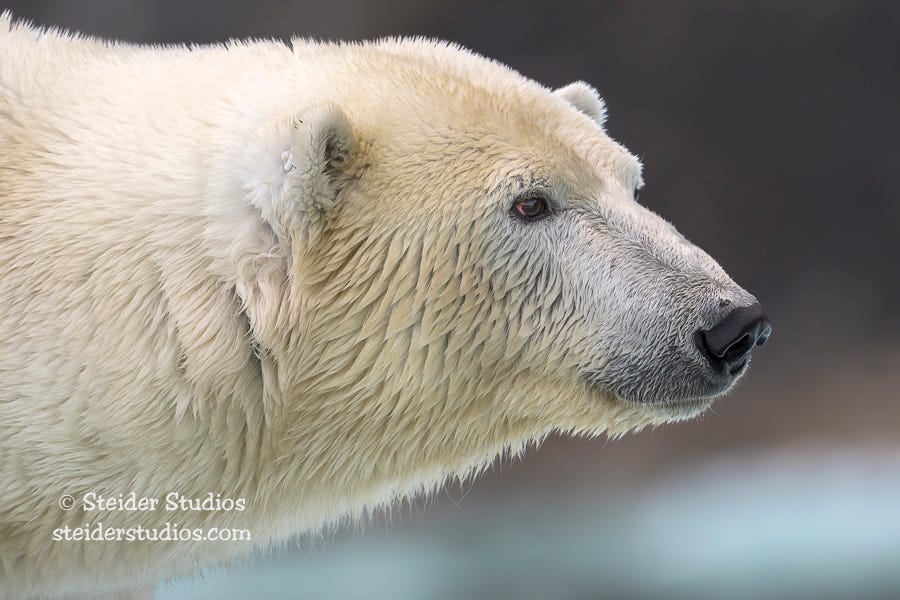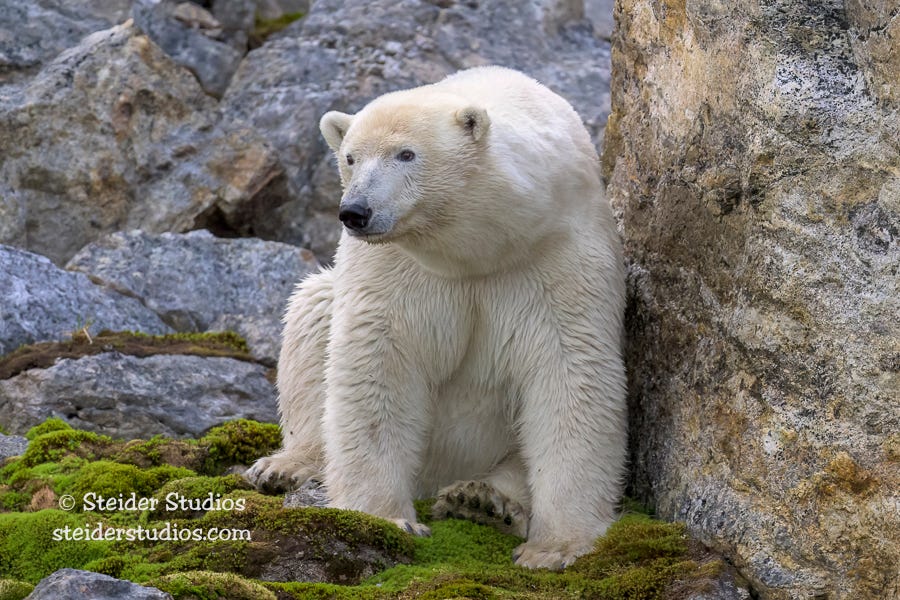Wild Stories is a monthly newsletter in which I write about an animal, a plant, a landscape, or a natural phenomenon. I have engaged with nature for decades through observation, physical experience, and study. Many species and ecological environments are threatened by habitat loss, climate chaos, and a lack of legal protection and kinship with the natural world. With Wild Stories, I share a bit about the lives of our flora and fauna and the incredible landscapes we live in.
I vaguely remember seeing polar bears on TV as a child. It was one of those early moments when my developing empathy wondered how those poor bears survived in such a harsh landscape. Weren’t they cold?
I didn’t think much more about polar bears until I read Barry Lopez’s 1986 book Arctic Dreams: Imagination and Desire in a Northern Landscape. The award-winning book offered me a tour of the Arctic environment from the warmth and comfort of my home. Working as a biologist in the Arctic over five years, Lopez frequently mentions the damp cold finding its way to his body despite layers of clothing and thermoses of hot coffee. He dedicates one chapter to polar bears, one of the world's largest land carnivores, describing their physicality, the science behind their adaptations, their seasonal and social behaviors, their expertise as hunters of seals, their physcial and mythological presence in the indigenous cultures of the north, and their unfortunate encounters with early European travelers. Beautifully written, the book balances science, art, history, and culture with literary expertise and Lopez’s keen observations and thinking.
I could stop here and simply recommend that you read the book. It’s the best source for learning about a place that few of us will visit, much less know intimately.
Linda Steider, a wildlife photographer who is sharing her beautiful photos for my Wild Stories articles, journeyed north to Svalbard last year to photograph polar bears, inspiring me to spend the past two weeks reading and watching about all things polar bears for this article.
“It was a profound experience and the greatest adventure of my lifetime. For 12 days, I was in constant wonder and awe, barely able to breathe while enveloped in arctic splendor.”
~ Linda Steider, Wildlife Photographer
The Well-Adapted Polar Bear
Polar bears expertly represent how habitat and landscape influence evolution and adaptation. The youngest bear species, polar bears likely branched off from the brown bear (Ursus arctos) lineage, which we call grizzlies in North America. Genetic sequencing continually updates the hypotheses about the origins and lineages of many species.
Male polar bears are often twice the size of females. Adult males’ weight ranges between 775 - 1,300 lbs. Adult females’ weight ranges between 330-650 lbs.
Their weight can fluctuate dramatically over a year due to a changing food supply.
They have an acute sense of smell and can smell food 10 miles away, which is key to their survival.
Their skin is black, an adaptation that helps them absorb heat.
Although they appear white to the human eye, their fur hairs are colorless.
With exposure to sunlight, the hairs change to hues of yellow.
From Arctic Dreams: …soft yellowish tones appear on the hips, along the flanks, and down the legs –a pale lemon wash, apricot yellows, cream buffs, straw whites…in the low sunlight of a fall afternoon, an older male’s fur might suggest the yellow golds of ripe wheat.
A polar bear's fur is the thickest of all bears. It consists of a dense undercoat topped with long guard hairs. This dual-layered coat provides waterproofing, insulation, and protection. A thick layer (up to 4.5 inches) of fat under the skin provides insulation and buoyancy. Due to these physical adaptations, polar bears can quickly overheat when they run, negating my childhood concerns about being cold.
What big paws you have! Dinner plate-sized paws act like snowshoes, distributing the bears’ weight on thin ice. Slightly webbed, the front paws serve as paddles and the hind legs as rudders when the bears swim. Their paws have a non-skid surface and strong hooked claws, enabling them to walk on sea ice and floes.
The scientific name for polar bears, Ursus maritimus, which means sea bear, notes their adaptation to marine environments. Their adaptations and ecological relationship with the northern seas classify them as marine mammals. They can hold their breath underwater for up to three minutes and swim many miles for long periods.
Life in the Far North
Polar bears live in the ice-covered waters of the Arctic and roam the adjacent coastal lands during the warmer months. In Arctic Dreams, Lopez describes the Arctic as a “desert landscape: spare, balanced, extended and quiet.” Biologists estimate there are 26,000 bears geographically grouped into 19 populations among five nations: Canada, Russia, Svalbard Archipelago of Norway, Greenland, and the United States (Alaska).
“Svalbard is a Norwegian archipelago in the Arctic Ocean halfway between Norway and the North Pole. I flew into Longyearbyen, a small village complete with a museum, art gallery, coffee shops, gift shops, and a central market.
Arriving a day early to explore, my guide carried a rifle to ward off potential bear encounters, which is a requirement of all guides. Buildings are left unlocked so that humans can duck in when bears meander through town. It’s illegal to trek outside city limits without a permitted weapon or a guide.
I learned from the museum director that Svalbard's ice is melting seven times faster than anywhere else in the world. Other locals told me of shrinking glaciers, rising ocean, and diminishing habitat for wildlife.” ~Linda Steider
A male polar bear lives a solitary, nomadic life roaming through water, ice, and land. The indigenous culture in Greenland calls them the Great Wanderers. Early observers speculated that the bears wandered the circumpolar region, following the ice around the North Pole, breeding in one place, traveling to another place to give birth, and the next generation continuing a clockwise journey to another country’s ice. Researchers quickly eliminated that theory and recognized that each population of bears prefers the region in which they were born. Unlike brown bears who claim a territory, Lopez notes that a polar bear’s “territory is something it carries with it over the ice.”
Mature females also roam but often with two or three cubs in tow. After mating in the spring, the female’s body is designed to delay blastocyst implantation until fall. Polar bears do not hibernate, but pregnant females create a den to give birth and nurture the cubs during the harsh winter months. She doesn’t hunt or eat during this time, living off her fat reserves. Cubs are born tiny (less than a pound), blind, deaf, hairless, and unable to walk. They nurse their mother’s fat-laden milk for 2-3 months before leaving the den as furry white balls of bear energy. They will stay with their mother for two years, playing and wandering the ice, water, and land, learning how to hunt and defend themselves.
Their Ecological Role
During the warmer summer months, bears move onto land, entering a fasting period. They may nibble on plants and eat lemmings, ducks, and other birds while waiting for the sea ice to freeze. Polar bears are strategic and patient hunters once they are back on the sea ice. Their primary prey are seals, who create breathing holes in the ice-covered water, popping up to breathe as necessary. Polar bears locate breathing holes and will still hunt: they patiently sit next to a hole, ready to grab the seal as it pops up. Gulls, foxes, and birds hover nearby, waiting for the bear to eat the seal’s blubber, leaving the rest of the carcass for the scavengers.
Climate Change and Polar Bears
In Gloria Dickie’s book, Eight Bears: Mythic Past and Imperiled Future, she asks:
What, then, is to become of the polar bear?
She notes that the polar bear defines the Arctic: the word arctic originates from arktos, the Greek word for bear. They are the apex predators and part of the complicated food chain that has evolved with the presence of sea ice.
The Arctic is warming 4x faster than the rest of the earth. The multi-year ice floes are disappearing, the seasonal ice is melting sooner and freezing later, and the Arctic waters are warming. Bears are forced to choose between staying on land, unable to hunt, or swimming much longer distances to get to the sea ice. Some polar bear populations are experiencing declines as high as 40%, primarily among cubs who aren’t strong enough to swim long distances. Polar bear pregnancies have a lower success rate each year. Fossil fuel exploration and production in the Arctic introduce toxins to the environment, and ships can navigate the seas without the danger of ice floes. The potential for a fossil fuel disaster is heightened.
Polar bears evolved rapidly to survive in their harsh habitat. They appear ghostly in their white landscape, blending into the snow and ice environment, challenging photographers to find them. In 2010, a study confirmed that without immediate and dramatic reductions in greenhouse gases, ⅔ of the polar bear population would be extinct by the end of this century.
Will they become ghosts of the Arctic?
In Arctic Dreams, Barry Lopez described his first sighting of a polar bear:
The bear turned in the water and regarded us with irritation, and then, wary, he veered toward a floe. In a single motion of graceful power, he rose from the water to the ice, his back feet catching the ice edge at the end of the movement. Then he stepped forward and shook. Seawater whirled off in flat sheets and a halo of spray. His head lowered, he glared at us with small, dark eyes. Then he crossed the floe, and, going down on his forelegs, sliding headfirst, he entered the water on the other side without a splash and swam off.
Thank you for being here. All of my posts are free, but if you’d like to support my work, you can do so by:
Liking and restacking this post so others are encouraged to read it.
Share this post via email or on social media.
Taking out a paid subscription to this Substack.
Comments are always welcome!
Note: To keep my newsletter shorter, I have not included the mythology of polar bears, the senseless killing brought to Arctic wildlife by early Europeans, the booming tourism to see polar bears, the occasional deaths of humans by polar bears, or the increasing danger of hungry and desperate polar bears a few coastal villages are experiencing. If you want to learn more, I have provided various resources.
Resources
Multi-media: Valemon the Bear: Myth in the Age of the Anthropocene featuring storyteller Martin Shaw
Book: Arctic Dreams: Imagination and Desire in a Northern Landscape by Barry Lopez
Book: Eight Bears: Mythic Pasts and Imperiled Future by Gloria Dickie
Book: Bear: A Celebration of Power and Beauty by Daniel Cox & Rebecca Grambo
Article: I Left My Heart In Svalbard
Documentaries: The Best 12 on Polar Bears
Documentary: The Great Polar Bear Feast - PBS
Short Film: Ghosts of the Arctic - A gorgeous 6-minute film on Svalbard
Polar Bears International - a non-profit that educates and advocates for polar bears
Photos: Linda Steider is a nature and wildlife photographer in White Salmon and co-owner of Made in the Gorge in Hood River. See more arctic wildlife photos at her gallery or www.steiderstudios.com and on Facebook or Instagram @Steider Studios.










Forgot to mention earlier...Barry Lopez's "Arctic Dreams" is interesting and profound, beautifully written (as you note) as are all his books. Like you, I seriously doubt I will ever visit the Arctic!
I enjoyed reading about polar bears. Thank you for the informative post and additional resources. The film "Ghosts of the Arctic" is beautiful and stark at the same time.